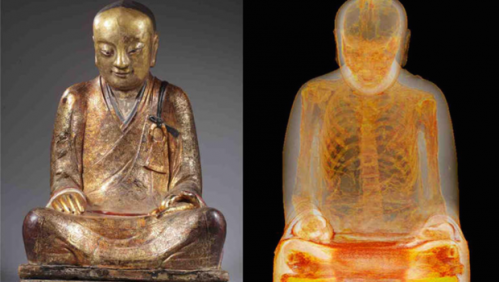February 24, 2015 weblog
CT scan taken of mummified remains in statue

(Phys.org) —A CT scan and endoscopy have revealed a master's mummy inside a Buddha statue. These were mummified remains of an ancient Buddhist monk who lived during the 11th or 12th century. Investigations revealed the skeletal frame of Buddhist master Liuquan, said the Toronto Sun, inside the bronze statue. Liuquan lived around the year 1100.
Discovery News said Monday that Liuquan was a member of the Chinese Meditation School. The discovery awakens interest on a number of levels—inquiries into the past practice of self-mummification is but just one; the other is the very nature of mummies, which continue to intrigue people. The Drents Museum, an art and history museum in Assen in the Netherlands, held an exhibition of mummies last year and provided a working description: "we speak of mummies when in addition to the bones the soft tissues such as skin, hair and muscles of a deceased person or animal have been preserved. Mummies are not only to be found in Egypt, but in all parts of the world." The museum noted how "New techniques give us a lot of information about life and death of the people who became mummies. This exhibition presents the results from such scientific research." The Buddha mummy was the exhibition's key eye-catcher, shown outside China last year at the museum's "Mummies-life beyond death" exhibit. This Buddha mummy is an interesting discovery. On the outside, it looks like a large statue of Buddha. Scan research has shown that on the inside it is a mummy of a Buddhist monk who lived around the year 1100. Was the mummy inside the Buddha statue a case of self-mummification? This was the question that the Drents museum site asked. Self-mummification is a process used to become "a living Buddha" and to achieve a higher level of enlightenment. China Topix said "Great Buddhist masters are often mummified to help them reach the Buddha-state."
A CT scan was performed at the Meander Medical Center in the Netherlands. Erik Bruijn, guest curator at the World Museum in Rotterdam and expert in Buddhist art and culture, led the research. At the hospital, gastrointestinal and liver doctor Reinoud Vermeijden and radiologist Ben Heggelman worked on an internal examination.
When the researchers had the statue scanned, they knew that a mummy was inside the statue. What they did not expect to discover, however, was that its organs were replaced by scraps of paper printed with ancient Chinese characters. Janene Van Jaarsveldt in the NL Times told the story of Vermeijden examining thoracic and abdominal cavities and finding "among all kinds of rotten material in the space where there had once been organs," the paper scraps printed with Chinese characters. Heggelman took the scan, and took samples of bone material for DNA testing. The team's research is expected to be published in an upcoming monograph, said Irish Archaeology. China Topix said the mummy was in a folded-up position like the Buddha statue itself.
The Buddha statue containing the mummified remains is on display in Hungary at the Natural History Museum. China Topix said it will be off to Luxembourg in May.
© 2015 Phys.org


















